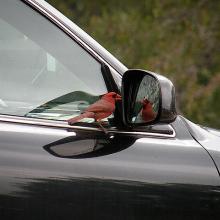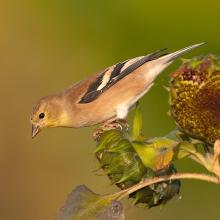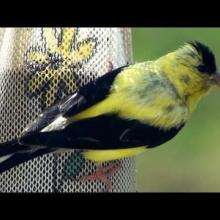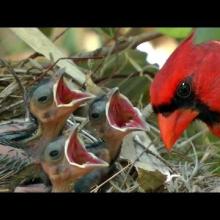

Join BirdNote tomorrow, November 30th!
Illustrator David Sibley and actor H. Jon Benjamin will face off in the bird illustration battle of the century during BirdNote's Year-end Celebration and Auction!
What's Going On with the Birds?
We often call the solstice "Midsummer," but it's actually only the beginning. August 1st is – strictly speaking – Midsummer. So what's going on in the bird world now? Like the week in Lake Wobegon, it's been mostly quiet. For the most part, the birds have stopped singing. No longer are we awakened at 4AM by the dawn chorus.
Many birds – wrens, robins, and others – may raise more than one brood in a breeding season. Depending on what part of the country you call home, your local birds may still be feeding fledglings, or those young ones might be completely independent by now. [Check out the story, Where Do Fledglings Go?]
This is the time of year when a lot of birds begin to look shabby. Crows are missing feathers, and male Mallards look almost like females. [Listen to Male Mallards Disappear] Northern Cardinals and Blue Jays can be positively bald! Cardinals are probably the most disturbing, because ... well, check this out.

© Greg Page
Don't be alarmed! It's their annual molt. Or one of two or more for some birds. American Goldfinches lose their bright summer colors in order to blend in with their dull winter surroundings. They'll molt again in the spring to show off those bright yellow feathers. [Listen to August Molt]

© Tom Grey
Some birds even lose the ability to sing after the breeding season is over. The part of the brain used for singing shrinks to lighten the bird's body mass. During the non-breeding seasons of fall and winter, most birds don’t need to sing to establish a breeding territory and attract a mate. Their lighter body mass makes them more agile and thus more likely to evade a predator during their winter foraging. [Listen to Birdsong Wanes with the Season]
Young raptors – those owls, hawks, and falcons – are learning to hunt for themselves. [Listen to a show about a Great Horned Owl family] Osprey juveniles also hang around with their parents for a while.

Juvenile Osprey in back, adult in front © Mike Hamilton
Precocial birds are off on their own, independent. Shorebird parents are halfway to their wintering grounds by now, and their young will follow soon, finding their way to the same general area, purely by instinct. [Learn more about shorebird migration]
Happily, many migratory birds will remain for a while longer. So what's the best time of day to look for them? Generally, songbirds are most active in the early morning, taking advantage of the abundance of insects at that hour. Mid-day heat sends people inside, and birds take a siesta, too. And then, both birds and bugs rev up again in the late afternoon. You'll see hummingbirds throughout the day – they must feed constantly to maintain that speedy metabolism. Gulls and those opportunistic crows stay busy, too.
What Can We Do for Birds in Summer?

American Robin © Tom Grey
In some parts of the country, summer can be quite dry. With global climate change, droughts are becoming more frequent. Natural sources of water have dried up. Creeks run low or underground. Rain is scarce, and temporary puddles are gone. And birds need water – to bathe and to drink.
A clean bath with sloping sides is a great way to start. Be sure to hose it out every day, otherwise the water will become stale and dirty, and mosquitoes may lay their eggs. OK, it's a fact: birds poop in their baths. And a robin taking a bath can splash out half the water in one go. On a hot day, you may find yourself on hose patrol, but the birds will love you for it.
If you have the time and inclination, go one step further and offer two or three birdbaths. Larger birds need deeper baths, which might pose a danger to small birds. An inch of water – or even less – is ideal for small birds. A wide, shallow birdbath that deepens a bit in the center will suit a broad range of birds. And some birds like to bathe closer to the ground. Certain shy birds will visit a birdbath set flat on the ground, but may shun a birdbath on a pedestal. (Just keep an eye out for cats! When a bird is refreshing itself in the spa, it's an easy mark for a cat.)
Want to really spoil your birds? Put out a mister, and watch the smaller birds – including chickadees, nuthatches, warblers, and especially hummingbirds – flit in and out. [Listen to A Magical Warbler Moment and You Need a Mister!] That's your special treat for extending a hand to these tiny creatures.
###
The story, How Birds Stay Cool, can tell you more.
This field note first appeared as a column on AWayToGarden.com, a collaboration with Margaret Roach.






